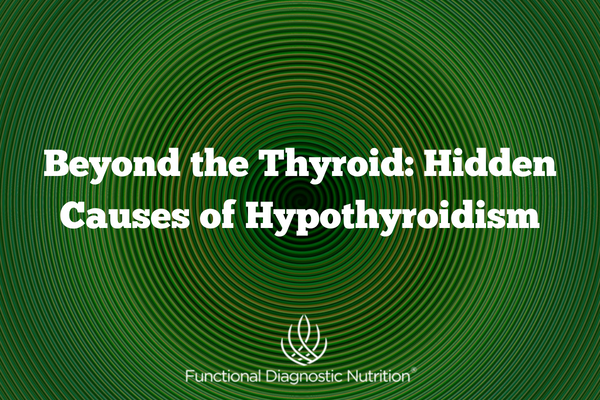As FDN practitioners, we so commonly work with clients suffering from symptoms related to thyroid issues: chronic fatigue, feeling cold all the time, constipation, weight gain, dry skin, hair loss. Some come to us with a diagnosis of hypothyroidism. Some suspect it. They hope that thyroid replacement hormone can solve all of their problems. Or they wonder why it’s not working.
As FDNs, we know the root cause of these symptoms isn’t hypothyroidism. Hypothyroidism is itself a symptom of other underlying issues that can trip up the delicate balance of the body’s metabolic homeostasis.
While it’s true that Hashimoto’s or thyroid cancer can damage the thyroid and impair its work, it’s also quite possible to have a perfectly healthy thyroid gland and still suffer from hypothyroidism.
The production of thyroid hormone is a complicated process. At each step of this process, dysfunctions and deficiencies can hinder the messaging, production, transportation, and uptake of active thyroid hormone.
Let’s take a closer look at how it works, and what can go wrong
- The Hypothalamus gets things started by sending a signal that thyroid hormone is needed. The hypothalamus is a gland in the brain that manages the body’s autonomic nervous system. One of its jobs is to monitor metabolism and body temperature. For example, when your core temperature drops, it sends Thyroid Releasing Hormone (TRH) to the pituitary gland, requesting more thyroid hormone to help raise your body temperature.
- What can go wrong: If the hypothalamus isn’t working properly, it can’t effectively send that request to the pituitary, and so the required amount of hormone won’t be produced. Causes of hypothalamus dysfunction include things like head trauma, infection, radiation, eating disorders, malnutrition, and excessive iron build-up in the body.
- The pituitary passes the message on. In response to receiving the TRH, the pituitary sends Thyroid Stimulating Hormone (TSH) to the thyroid gland, telling it to produce T4 and T3.
- What can go wrong: If your client is under chronic stress and the pituitary is also being asked for more cortisol, the request for thyroid hormone will be deprioritized in favor of cortisol.
- The thyroid gland gets to work. The thyroid receives TSH, signaling it to produce thyroid hormones. Thyroglobulin, created by the follicular cells in the thyroid, contains tyrosine and iodine. Through the action of the Thyroid Peroxidase (TPO) enzyme (aided by selenium, zinc, manganese, and other nutrients), it binds them together to create T4 and a small amount of T3. Tyrosine plus four iodine molecules is T4. Tyrosine plus three iodine molecules is T3. (T1, T2, and Calcitonin are also produced, but are less studied in terms of their role in metabolic function).
- What can go wrong: Nutrient deficiencies of tyrosine, iodine, selenium, zinc, or manganese can inhibit thyroid hormone production. A thyroid damaged by Hashimoto’s autoimmunity or thyroid cancer will also be unable to effectively create the needed thyroid hormones.
- Hormones load up for transport. Thyroid Binding Globulin (which is produced in the liver) binds the T4 and T3 to transport it to the liver and gut for conversion.
- What can go wrong: If the liver is congested due to things like exposure to toxins, food sensitivities, or gut pathogens, it won’t be able to produce as much TBG. This means that even if enough hormones are produced by the thyroid, they cannot be effectively transported for conversion.
- The liver spins straw into gold. The liver is where 60% of the conversion from T4 to active and bioavailable T3 takes place. Here, the deiodinase enzyme system removes one iodine molecule from T4 to create T3 for the cells.
- What can go wrong: If your client has elevated cortisol or a congested liver, the ability to convert from T4 to T3 will be compromised.
- The liver also provides the brakes. 20% of T4 is converted into inactive reverse T3 (rT3), slowing metabolism down when needed (such as when you are sick and the body would like to conserve energy). While too much rT3 is not a good thing, we do need some to keep the body in balance. The liver also produces two other inactive T3 forms: T3 sulfate (T3S) and triiodothyroacetic acid (T3AC), which are sent to the GI tract for conversion.
- What can go wrong: Elevated cortisol levels due to stress drive up production of rT3, which results in slowed metabolism. High levels of rT3 are often correlated with things like chronic stress, trauma, heavy metal toxicity, calorie-restricted diets, infections, inflammation, liver/kidney dysfunction, and certain medications and nutrient deficiencies. Additionally, the same congested liver that impaired T4 to T3 conversion, also impairs conversion of T4 to T3S and T3AC, which means less potential for active T3 conversion in the gut.
- The gut adds fuel to the metabolic fire. Healthy gut flora in the GI tract produces an enzyme called intestinal sulfatase, which converts that T3S and T3AC sent from the liver into active T3. This is just one way in which a healthy microbiome enhances immune health.
- What can go wrong: If your client’s gut is compromised due to things like food sensitivities, excessive sugar/carbs, SIBO, or parasitic infections, they miss out on the opportunity to maximize bioavailable T3.
- Thyroid hormones goes out for delivery. The liver produces Thyroid Binding Globulin (TBG), which binds the hormones and carries them through the blood stream to the cells and tissues that need them.
- What can go wrong: When the liver is congested and those TBG levels are reduced, the ability to transport active hormone to the cells is slowed. On the other hand, if too much TBG is created, a higher percentage of hormones become bound up, which reduces their bioavailability. Lastly, if iron levels are inadequate to effectively move the TBG through the blood, the T4 builds up. The body clears excessive T4 by converting it to more inactive rT3.
- Cells and tissues fuel up. The TBG releases free T3, which is brought in through receptors on the cell membrane to be utilized by mitochondria in order to keep our metabolism humming along in a state of homeostasis.
- What can go wrong: Elevated cortisol due to a variety of stressors can inhibit free T3 from actually entering the cells. Oxidative stress damages cell membranes, making them less absorbent. If the liver is too congested to effectively clear estrogen, that excess estrogen will compete with T3 at the TBG receptor sites, reducing the cell’s ability to access that bioavailable T3. Once in the cell, a number of nutritional issues can inhibit utilization. Key suspects may be a potassium deficiency, the presence of toxins such as chloride from bleached flour products and fluoride, or over-consumption of raw goitrogenic vegetables like kale, cabbage, cauliflower or broccoli.
Rinse, repeat
To make matters worse, when a lack of thyroid hormones lowers metabolism, gut motility as well as liver and gallbladder function are slowed. This makes an already congested liver even worse. And those with low thyroid hormones have a harder time managing stressors, which also taxes the HPA axis, deprioritizing thyroid hormone. So, it becomes a vicious cycle.
What can you do as an FDN practitioner?
Just understanding the intricacies of the process of creating and assimilating thyroid hormone can help us to better identify the root cause of hypothyroidism and create more successful DRESS protocols. It also helps us give our clients a deeper understanding about the relationship between food/lifestyle choices and healthy thyroid function.
The Advanced Thyroid Course offered through ADFNP, taught by fellow FDN practitioner Whitney Morgan, goes through all of this in much more depth. It also covers hyperthyroidism, autoimmune thyroid conditions like Hashimoto’s, Graves’ Disease, and Addison’s Disease. You’ll learn:
- Detailed physiology of the thyroid and related disorders/diseases
- How various dysfunctions and deficiencies in the body affect thyroid hormone production, transport, and uptake
- How to properly test for thyroid dysfunction
- Which tests are available to FDNs, and the pros and cons of each
- How to interpret these tests to understand what part of the process is broken
- How to support those different potential functional issues through DRESS
- What supplementation strategies may be most effective based on dysfunction type
This comprehensive course is a must-have for those who want to be best positioned to successfully understand, identify, and support thyroid issues in their practice.
———–
Note from author: I have personally taken this course and am impressed by all the information packed into it. Whitney is incredibly knowledgeable and shares what she knows in an easily digestible format. I am far more prepared for dealing with clients with complaints relating to thyroid function because of it. And lifetime access means I’ll always be able to refer back to it when dealing with tricky cases. I couldn’t recommend it more highly.








